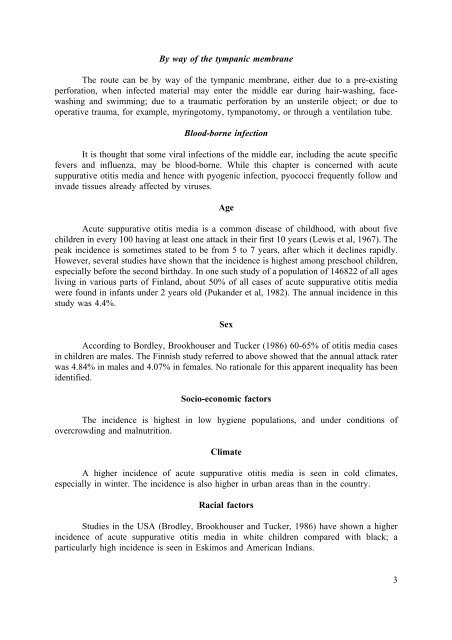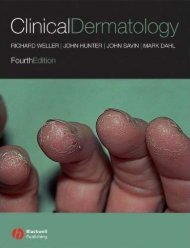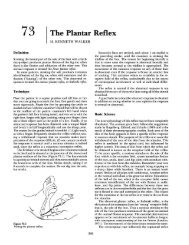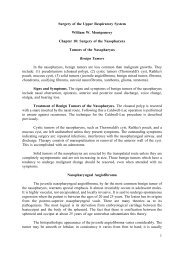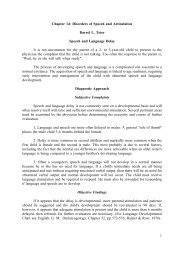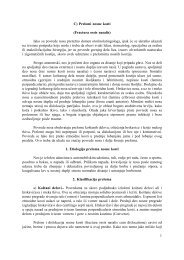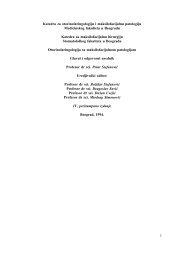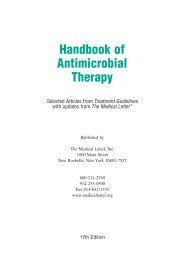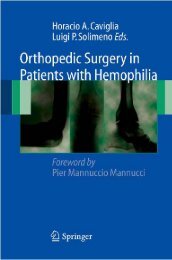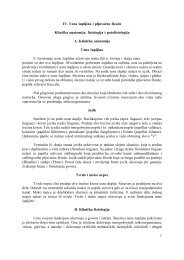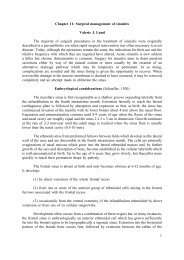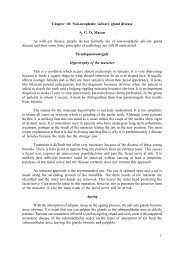1 Chapter 13: Acute suppurative otitis media and acute mastoiditis ...
1 Chapter 13: Acute suppurative otitis media and acute mastoiditis ...
1 Chapter 13: Acute suppurative otitis media and acute mastoiditis ...
Create successful ePaper yourself
Turn your PDF publications into a flip-book with our unique Google optimized e-Paper software.
By way of the tympanic membrane<br />
The route can be by way of the tympanic membrane, either due to a pre-existing<br />
perforation, when infected material may enter the middle ear during hair-washing, facewashing<br />
<strong>and</strong> swimming; due to a traumatic perforation by an unsterile object; or due to<br />
operative trauma, for example, myringotomy, tympanotomy, or through a ventilation tube.<br />
Blood-borne infection<br />
It is thought that some viral infections of the middle ear, including the <strong>acute</strong> specific<br />
fevers <strong>and</strong> influenza, may be blood-borne. While this chapter is concerned with <strong>acute</strong><br />
<strong>suppurative</strong> <strong>otitis</strong> <strong>media</strong> <strong>and</strong> hence with pyogenic infection, pyococci frequently follow <strong>and</strong><br />
invade tissues already affected by viruses.<br />
Age<br />
<strong>Acute</strong> <strong>suppurative</strong> <strong>otitis</strong> <strong>media</strong> is a common disease of childhood, with about five<br />
children in every 100 having at least one attack in their first 10 years (Lewis et al, 1967). The<br />
peak incidence is sometimes stated to be from 5 to 7 years, after which it declines rapidly.<br />
However, several studies have shown that the incidence is highest among preschool children,<br />
especially before the second birthday. In one such study of a population of 146822 of all ages<br />
living in various parts of Finl<strong>and</strong>, about 50% of all cases of <strong>acute</strong> <strong>suppurative</strong> <strong>otitis</strong> <strong>media</strong><br />
were found in infants under 2 years old (Puk<strong>and</strong>er et al, 1982). The annual incidence in this<br />
study was 4.4%.<br />
Sex<br />
According to Bordley, Brookhouser <strong>and</strong> Tucker (1986) 60-65% of <strong>otitis</strong> <strong>media</strong> cases<br />
in children are males. The Finnish study referred to above showed that the annual attack rater<br />
was 4.84% in males <strong>and</strong> 4.07% in females. No rationale for this apparent inequality has been<br />
identified.<br />
Socio-economic factors<br />
The incidence is highest in low hygiene populations, <strong>and</strong> under conditions of<br />
overcrowding <strong>and</strong> malnutrition.<br />
Climate<br />
A higher incidence of <strong>acute</strong> <strong>suppurative</strong> <strong>otitis</strong> <strong>media</strong> is seen in cold climates,<br />
especially in winter. The incidence is also higher in urban areas than in the country.<br />
Racial factors<br />
Studies in the USA (Brodley, Brookhouser <strong>and</strong> Tucker, 1986) have shown a higher<br />
incidence of <strong>acute</strong> <strong>suppurative</strong> <strong>otitis</strong> <strong>media</strong> in white children compared with black; a<br />
particularly high incidence is seen in Eskimos <strong>and</strong> American Indians.<br />
3


